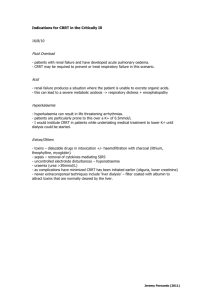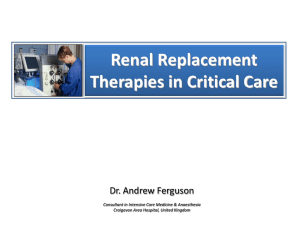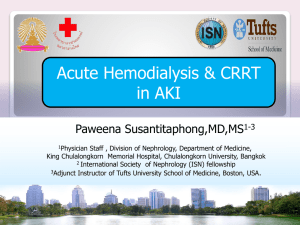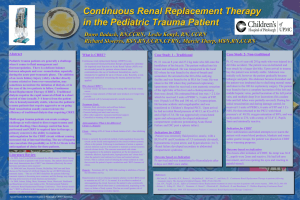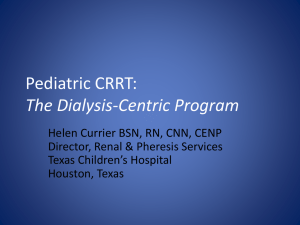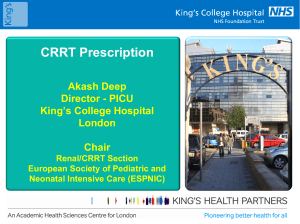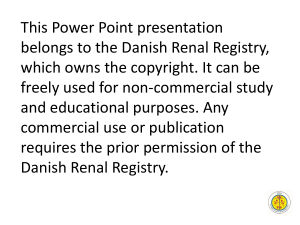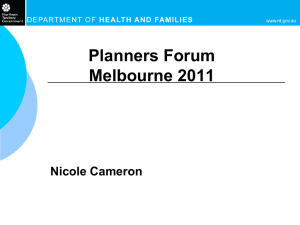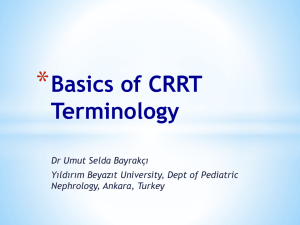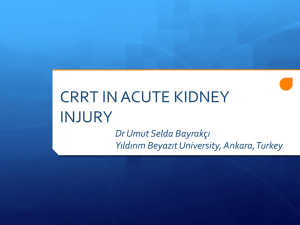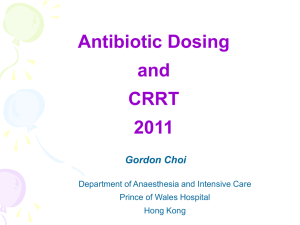Bunchman-RRT Options - Pediatric Continuous Renal
advertisement
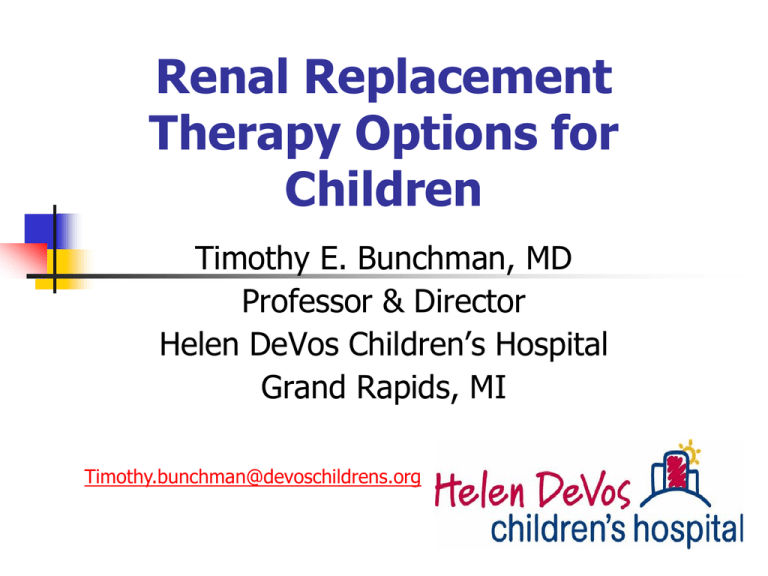
Renal Replacement Therapy Options for Children Timothy E. Bunchman, MD Professor & Director Helen DeVos Children’s Hospital Grand Rapids, MI Timothy.bunchman@devoschildrens.org Questions? Is there an optimal form of RRT in children independent of cause of AKI? Are there studies comparing outcome randomized by RRT modality in children? RRT Options (all are reasonable to use) PD (continuous or intermittent) HD (intermittent) Acute, CAPD, CCPD Standard vs High Flux CRRT (continuous) CVVH, CVVHD, CVVHDF Dialysis (diffusive) PD vs. HD vs. CVVHD Works with solute clearance across a semipermeable membrane The greater the gradient the greater the clearance The greater the solution exposure per unit of time the greater the clearance Diffusive Clearance CVVHD/HD/PD Diffusive clearance Dialysate Physiologic sterile solution that is infused countercurrent to the blood flow rate (Qd) Replacement (Convective) Due to mass transfer (push) of solute thru a semi-permeable membrane The pore size of the membrane may effect clearance AN-69 membrane > Polysulphone The greater the solution exposure per unit of time the greater the clearance Convective Clearance CVVH Convective clearance Replacement Solutions Physiologic sterile solution that is either infused pre filter (NA) or post filter (outside of NA) that infused at a set rate (Qr) Convective and Diffusive Clearance CVVHDF Convective clearance Replacement Solutions Diffusive clearance Dialysis solution Sieving Coefficients Solute (MW) Convective Coefficient Diffusion Coefficient Urea (60) 1.01 ± 0.05 1.01 ± 0.07 Creatinine (113) 1.00 ± 0.09 1.01 ± 0.06 Uric Acid (168) 1.01 ± 0.04 0.97 ± 0.04* Vancomycin (1448) 0.84 ± 0.10 0.74 ± 0.04** Calcium (protein bound) 0.67 + 0.1 0.61 + 0.07 Cytokines (large) *P<0.05 **P<0.01 adsorbed minimal clearance Impact of urea Clearance CVVH vs CVVHD (Maxvold et al, Crit Care med. 2000 Apr;28(4):1161-5) Study design Fixed blood flow rate-4 mls/kg/min HF-400 (0.3 m2 polysulfone) Cross over for 24 hrs each to prefilter replacement fluid (CVVH) or Dx (CVVHD) flow at 2000 mls/hr/1.73 m2 Comparison of Urea Clearance: CVVH vs CVVHD Urea Clearance (mls/min/1.73 m2) (Maxvold et al, Crit Care med. 2000 Apr;28(4):1161-5) p = NS BFR = 4 mls/kg/min FRF/Dx FR = 2 l/1.73 m2/hr SAM = 0.3 m2 Solute clearance vs UF Solute Clearance/unit of time HD > HF > PD (30-50 l/hr vs 2 l/hr vs 1-2 /hr Dx) UF with regard to hemodyamics HF > PD > HD (24 hrs/day vs 3-4 hrs/day or QO Day) Dialysis Dose 10 9 8 7 6 5 4 3 2 1 0 35ml/kg EDD CRRT 20ml/kg 7 6 5 4 3 2 PD 0.3 0.5 0.7 0.9 1.1 1.3 1.5 eKt/V each dialysis Adapted from Gotch et al. Kidney Int 2000;58:S3-18 No. of Days/week Weekly stdKt/V 45ml/kg Dialysis Dose and Outcome Ronco et al. Lancet 2000; 351: 26-30 425 patients Endpoint = survival 15 days after D/C HF 146 UF rate 20ml/kg/hr survival significantly lower in this group compared to the others 139 UF rate 35ml/kg/hr p=0.0007 140 UF rate 45ml/kg/hr p=0.0013 • Conclusions: – Minimum UF rates should be ~ 35 ml/kg/hr – Survivors had lower BUNs than non-survivors prior to commencement of hemofiltration Relative Advantages (+) and Disadvantages (-) of CRRT, IHD, and PD Variable CRRT IHD PD --------------------------------------------------------------------------------------------- Continuous RRT + Hemodynamic stability + Fluid balance achievement + - - + + - Relative Advantages (+) and Disadvantages (-) of CRRT, IHD, and PD Variable CRRT IHD PD --------------------------------------------------------------------------------------------Unlimited nutrition + Superior metabolic control + - - Continuous removal of toxins + - + Simple to perform ± - + Relative Advantages (+) and Disadvantages (-) of CRRT, IHD and PD cont. Variable CRRT IHD PD -------------------------------------------------------------------------------------- Stable intracranial pressure + - + Rapid removal of poisons - + - Limited anticoagulation -/+ + + Relative Advantages (+) and Disadvantages (-) of CRRT, IHD and PD cont. Variable CRRT IHD PD --------------------------------------------------------------------------------------------- Intensive care nursing support + - + Hemodialysis nursing support ± + + Patient mobility - + - Percent of Patients (%) PATIENT MORTALITY N=21 N=9 Modality Fleming et al., J Thorac Cardiovasc Surg, 1995 (NS in mortality) N=12 % Change From Baseline CALORIC INTAKE CAVH * CVVH * PD Modality(* p < 0.05 compared to PD) Fleming et al., J Thorac Cardiovasc Surg, 1995 Renal Replacement Therapy in the PICU Pediatric Outcome Literature 122 children studied No PRISM scores Most common diagnosis IHD: primary renal failure CRRT: sepsis 31% survival Conclusion: patients who receive CRRT are more ill Maxvold NJ et al: Am J Kidney Dis 1997 Nov;30(5 Suppl 4):S84-8 Pediatric ARF: Modality and Survival % Survival P<0.01 P<0.01 Ped Neph 16:1067-1071, 2001 (ns) Pediatric ARF: Modality and Survival Patient survival on pressors (35%) lower than without pressors (89%) (p<0.01) Lower survival seen in CRRT than in patients who received HD for all disease states Ped Neph 16:1067-1071, 2001 Unique Situations-PD Infants and Post Op Hearts Ease of fluid management Ease of administration at bedside Chien et al Pediatr Neonatol 2009; 50:25-279 Bonillis-Felix PDI 2009 29 S183-185 Limited resources The etiology of acute renal failure- Nigeria ( Anochie & Eke Peds Neph 2005:20 1610-1614) Etiology Number (%, N=211) Gastroenteritis 61 (28.9) Septicaemia 32 (15.2) With Tetanus 4 (5.3) Acute glomerulonephritis 29 (13.7) Plasmodium falciparum malaria 29 (13.7) Birth asphyxia 27 (12.8) Haemolytic uraemic syndrome 7 (3.3) Malignancy 6 (2.8) Leukaemia 4 Burkitt lymphoma 2 HIV related 3 (1.4) Congenital malformation 10 (4.7) Posterior urethral valves 6 Renal agenesis 4 Renal vein thrombosis 1 (0.5) The etiology of acute renal failureNigeria ( Anochie & Eke Peds Neph 2005:20 1610-1614) 211 Patients with ARF over an 18 year period Dialysis indicated in 108 patients Only 24 had PD– due to resource availability and cost Primary causes of death- uremia, infection, anemia, hypertension and LACK of Dialysis Unique Situations-HD (+/CRRT) Conditions when maximal solute clearance is needed with less concern on hemodynamic stability Auron and Brophy Current opinions in Pediatrics 2010 22: 283-188 Quan and Quigley Current opinions in Pediatrics 2005 17: 205-209 Vancomycin clearance High efficiency dialysis membrane Rx Rx Rebound Time of therapy Rx Rebound Unique Situations-CRRT When hemodynamic instability and highly catabolic conditions are present Sepsis Bone Marrow Transplantation Goldstein SL Seminars in Dialysis 2009; 22; 180-184 Walters et al Pediatr Neph 2009 24; 37-38 Stem Cell Transplant: ppCRRT 51 patients in ppCRRT with SCT Mean %FO = 12.41 + 3.7%. 45% survival Convection: 17/29 survived (59%) Diffusion: 6/22 (27%), p<0.05 Survival lower in MODS and ventilated patients Flores FX et al: Pediatr Nephrol. 2008 Apr;23(4):625-30 Intensive vs non Intensive RRT HD and CRRT at 6 days per week and 35 mls/kg/hr daily Vs. HD and CRRT at 3 days per week and 20 mls/kg/hr daily Intensity of Renal Support in Critically Ill Patients with Acute Kidney Injury The VA/NIH Acute Renal Failure Trial Network* NEJM july 3, 2008 vol. 359 no. 1 Enrollment, Randomization, and Follow-up of Study Patients The VA/NIH Acute Renal Failure Trial Network. N Engl J Med 2008;359:7-20 Intensive vs Conventional Primary and Secondary Outcomes The VA/NIH Acute Renal Failure Trial Network. N Engl J Med 2008;359:7-20 Kaplan-Meier Plot of Cumulative Probabilities of Death (Panel A) and Odds Ratios for Death at 60 Days, According to Baseline Characteristics (Panel B) The VA/NIH Acute Renal Failure Trial Network. N Engl J Med 2008;359:7-20 Summary of Complications Associated with Study Therapy The VA/NIH Acute Renal Failure Trial Network. N Engl J Med 2008;359:7-20 Conclusion of ATN Study Intensive renal support in critically ill patients with AKI did not decrease mortality, improve recovery of kidney function, or reduce the rate of nonrenal organ failure as compared with less-intensive therapy involving a defined dose of IHD three times per week and CRRT at 20 ml per kilogram per hour. Flow chart of the SHARF 4 study Lins, R. L. et al. Nephrol. Dial. Transplant. 2009 24:512-518; doi:10.1093/ndt/gfn560 Copyright restrictions may apply. Outcome in patients randomized to intermittent (IRRT) or continuous (CRRT) renal replacement therapy Lins, R. L. et al. Nephrol. Dial. Transplant. 2009 24:512-518; doi:10.1093/ndt/gfn560 Copyright restrictions may apply. Survival curves in patients randomized to intermittent (IRRT) or continuous (CRRT) renal replacement therapy investigating ICU mortality and hospital mortality Lins, R. L. et al. Nephrol. Dial. Transplant. 2009 24:512-518; doi:10.1093/ndt/gfn560 Copyright restrictions may apply. Cost of Dialysis Equipment (in U.S. dollars) Manual Peritoneal Dialysis Device: Dialy-Nate Manual PD set Manufacturer: Utah Medical Products Cost per Unit: $88.75 (New set Required every 2472 h) Cost of additional Supplies: 1.5% Dineal (Baxter) $24.43/2.0L Cost of Dialysis Equipment (in U.S. dollars) cont. Manual Peritoneal Dialysis Device: Ultra Set (Y-set) Manufacturer: Baxter Cost per unit: $6.95 (New unit required for each exchange) Cost of additional Supplies: 1.5% Dianeal (Baxter) $24.43/2.0L Cost of Dialysis Equipment (in U.S. dollars) cont. Automated Peritoneal Dialysis Device: Freedom Cycler Manufacturer: Fresenius Cost per unit: $12,295.00 Cost of additional supplies: Pediatric Tubing set $32.00 each Cost of Dialysis Equipment (in U.S. dollars) cont. Intermittent Hemodialysis Device: C3 Manufacturer: Gambro Cost per unit: $18,000.00 Cost of additional Supplies: 100HG dialyzer $50.00 each; pediatric bloodlines $11.40 each Cost of Dialysis Equipment (in U.S. dollars) cont. Continuous Hemofiltration Device: Prisma Manufacturer: Gambro Cost per unit: $25,000.00 Cost of additional supplies: M60 hemofilter set (includes filter and bloodlines) $160.00 Normocarb dialysate concentrate (Dialysis Solutions) $20.00/3.0L Conclusion RRT modality comparison shows that the dose of RRT and the choice of RRT may not effect survival Indication to begin, end is still of question Do what you do well and improve your care of patient with AKI
